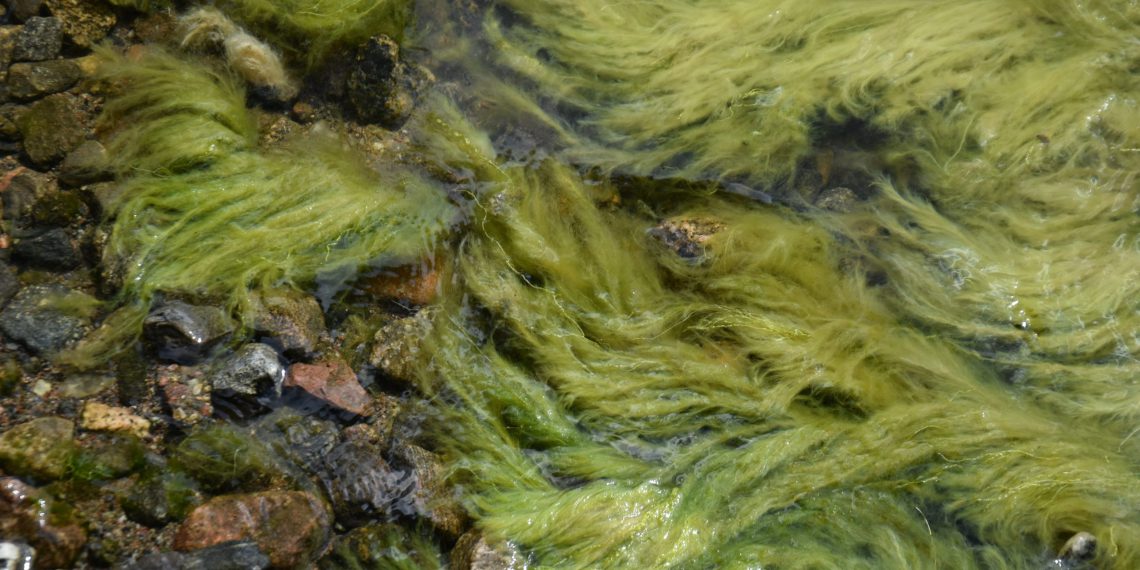Now, some of the world’s clear lakes are affected by a new phenomenon: Near the shore, where people play or swim, the lake bottom is covered with green carpets of algae. These are mass accumulations of filamentous algae that are now appearing even in remote mountain lakes, as well as in some large lakes such as Lake Tahoe (USA) and Lake Baikal (Russia). An international group of lake researchers, including the Leibniz Institute of Freshwater Ecology and Inland Fisheries (IGB), has drawn attention to the problem and identified possible causes. This is because filamentous algal blooms profoundly alter the ecosystem and can cause problems for water use.
In a recent technical publication, an international research team has compiled the possible triggers for the observed mass developments of filamentous algae in clean lakes. Local and global influences are discussed: increasing nutrient inputs, loss of filamentous algae-feeding aquatic animals, climate change, and invasive species.
Little is known about the ecological impacts, and there are risks for bathers
 Filamentous algae are not a single species; many different species are grouped under this term based on their appearance. Mass accumulations of filamentous algae can threaten communities of other creatures on the lake bottom and alter food webs; however, researchers do not yet know many of the potential impacts. For bathers, the green algal carpets are not only unsightly — toxins from cyanobacteria can also accumulate in them. Dogs seem to be attracted by the fishy smell of the algae and then run the risk of ingesting the toxins. “In Germany, too, there are problems with mass developments of filamentous algae on some lakes,” says IGB researcher Dr. Sabine Hilt, co-author of the study.
Filamentous algae are not a single species; many different species are grouped under this term based on their appearance. Mass accumulations of filamentous algae can threaten communities of other creatures on the lake bottom and alter food webs; however, researchers do not yet know many of the potential impacts. For bathers, the green algal carpets are not only unsightly — toxins from cyanobacteria can also accumulate in them. Dogs seem to be attracted by the fishy smell of the algae and then run the risk of ingesting the toxins. “In Germany, too, there are problems with mass developments of filamentous algae on some lakes,” says IGB researcher Dr. Sabine Hilt, co-author of the study.
Previous paradigm: nitrogen and phosphorus favor algal development
Until now, mass developments of algae were mainly a phenomenon in lakes with high inputs of nitrogen and phosphorus. These nutrients usually enter water bodies via agriculture or urban runoff and promote algal growth.
In contrast, algae species that are inconspicuous — growing slowly and in deeper water layers where enough light still reaches due to the clarity of the water — were considered typical of clear and nutrient-poor lakes.
“We’re very surprised that lakes we’ve had little to worry about as ecologists are now being affected by filamentous algal blooms in the shallow shore zone.”
- Sabine Hilt
Even clear lakes are increasingly polluted with nutrients: Lake Baikal example
Filamentous algae have higher nutrient requirements, especially for nitrate and ammonium, than the smaller, slow-growing species they replace. In fact, in some formerly clear and nutrient-poor lakes, nutrient loading has increased in recent years. One example is Lake Baikal in Siberia — known for its unparalleled richness of animal and plant species. This biodiversity is under threat, as the mass of filamentous algae has increased fivefold in the last ten years. One possible reason for this is nitrogen and phosphorus inputs from untreated human sewage discharged into the lake. Forest fires have also caused more nutrients from surrounding areas to enter the lake.
Filamentous algae-eating microorganisms are absent
Lead author Dr. Yvonne Vadeboncoeur, a professor at U.S. Wright State University, is concerned that widespread use of pesticides or other stressors are killing off microorganisms in the water body. This process, too, could be contributing to filamentous algae spreading instead of being eaten.
Climate change will increase filamentous algae blooms in general
Another author of the study, Dr. Sudeep Chandra of the U.S. University of Nevada, points out that filamentous algae are appearing in clear mountain lakes in the western United States because water temperatures are rising and summers are getting longer. In Lake Tahoe, the increased occurrence of extensive filamentous algal blooms in shallow shorelines is linked to shorter snow cover and changes in subsurface water flow due to climate change. Various indirect effects, for example on food web structure, are often stronger in their impact than the changes caused directly by temperature.
Invasive zebra mussel improves living conditions for filamentous algae
In the Great Lakes of North America, the alien zebra mussel became widespread 30 years ago. The small crustaceans live on free-floating organisms in the water — the plankton — and make the nutrients bound in them available to filamentous algae. The strong spread of the zebra mussel was therefore accompanied by mass developments of filamentous algae in the riparian zones.
Citizens could be helpful in monitoring
“Our review study suggests that multiple environmental stressors influence the phenomenon. However, we still know far too little about where and to what extent filamentous algae proliferate. For most long-term studies, water samples are taken from the middle of the lake and studied in terms of plankton, while the shore has been less of a focus. That needs to change. However, observing filamentous algal developments is complex because their occurrences are heterogeneous and often localized. Therefore, lay researchers — Citizen Scientists — sharing their observations via cell phone could also be helpful. The use of remote sensing methods will also certainly gain in importance,” is Sabine Hilt’s outlook.

















